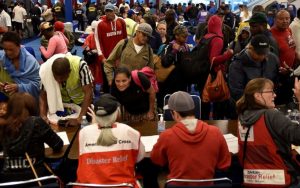In It for the Long Haul
September 21, 2017The nation is rallying around the communities affected by Hurricanes Harvey and Irma with an outpouring of support for human service organizations addressing immediate concerns, such as safe food and water, housing, and clothing. Human services will also play a vital role in rebuilding communities over the months and years of the recovery process, but this part of the story can get buried as the nation’s attention naturally shifts over time to other concerns.

Volunteers with The American Red Cross register evacuees at the George R. Brown Convention Center after Hurricane Harvey inundated the Texas Gulf coast with rain causing widespread flooding, in Houston. Source: ABC News
In a piece published in the Chronicle of Philanthropy, Allison Sesso, Executive Director of the Human Services Council of New York, explains the ongoing role human services play in disaster-affected communities. Relying on lessons learned following Hurricane Sandy in 2012, Sesso offers practical strategies for equipping human service organizations with the tools and resources needed for immediate and long-term disaster recovery efforts. From a reframing perspective, Sesso makes use of the Construction Metaphor to draw an analogy between rebuilding theinfrastructure of communities and rebuilding the well-being of the people living in the affected communities:
“As America begins the long recovery from Hurricanes Harvey and Irma, governments and businesses will spend billions of dollars rebuilding infrastructure. But it is the nonprofit world that will play a key role in rebuilding the lives of those affected by the devastating hurricanes.”
We know that the Construction Metaphor helps the public understand what human services are, how underlying systems and conditions contribute to needing access to human services, and how human services foster well-being over the course of a lifetime. It can be a powerful way for organizations to explain the need for continued support after the initial recovery efforts, particularly when shared as part of the broader Building Well-Being Narrative.

